| A | B |
|---|
| Organisms that must consume organic molecules for a source of carbon to build other organic molecules are called _____. | heterotrophs (The two types of heterotrophs are photoheterotrophs and chemoheterotrophs.) p564 |
| Any organism that can use some form of carbon dioxide as its carbon source is called a(n) _____. | autotroph (The two types of autotrophs are photoautotrophs and chemoautotrophs) p565 |
| The assimilation of atmospheric nitrogen by certain prokaryotes into nitrogenous compounds that can be directly used by plants is called ____. | nitrogen fixation p564 |
| The larger participant in a symbiotic relationship, serving as home and feeding ground to the symbiont is called the ____. | host p570 |
| A staining method that distinguishes between two different kinds of bacterial cell walls is called the ____. | gram stain p557,  |
| The sticky layer that surrounds the cell walls of some bacteria, protecting the cell surface and sometimes helping to glue the cell to surfaces is called the ____. | capsule (Its called a capsule if it is dense and well defined. If it is less well organized, it is called a slime layer) p558,  |
| A thick-coated, resistant cell produced within a bacterial cell exposed to harsh conditions is called a(n) ____. | endospore p560,  |
| Movement toward or away from a stimulus is called _____. | taxis p558 |
| A small ring of DNA that carries accessory genes separate from those of a bacterial chromosome is called a(n) ____. | plasmid (plasmids are also found in some eukaryotes, such as yeast) p560, 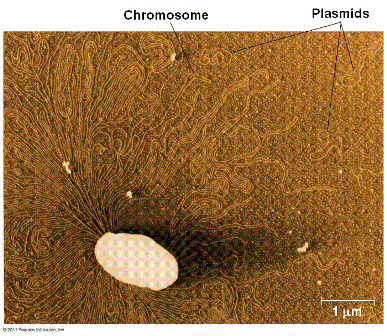 |
| An ecological relationship between organisms of two different species that live together in direct contact is called _____. | symbiosis p570 |
| An organism that absorbs nutrients from the body fluids of living hosts would be classified as a(n) ____. | parasite p570 |
| A bacterium that absorbs nutrients from nonliving organic materials such as corpses, fallen plant material, and the wastes of living organisms and converts them into inorganic forms would be classified as a(n) ____. | decomposer p570 |
| A symbiotic relationship in which the symbiont benefits at the expense of the host is called ____. | parasitism p570 |
| A symbiotic relationship in which both participants benefit is called ____. | mutualism p570 |
| A symbiotic relationship in which the symbiont benefits but the host is neither helped nor harmed is called _____. | commensalism p570 |
Prokaryotic cells lack _______, 
| a nucleus and other membrane-bound organelles pp559&560 |
| Cells that have a nucleus and membrane bound organelles are called ____ cells. | eukaryotic G-13, 
|
| Bacteria that stain purple are known as _______ . | gram-positive bacteria p557,  |
| Bacteria that don't stain purple are known as ______. | gram-negative bacteria p557,  |
| Mutualism, parasitism and commensalism are all types of ____. | symbiosis p570, 
|
| Some bacteria have a whip-like tail called a ____. | flagellum p558, 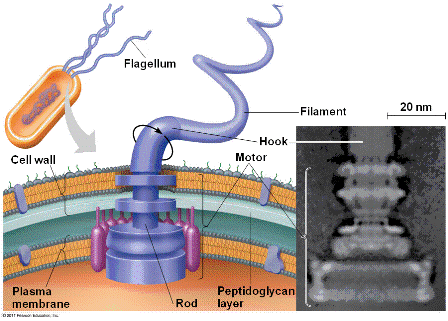 , , 
|
| The structure just outside the cell membrane of a bacterium is called the ___. | cell wall p557,  |
| Which gas in the atmosphere do some bacteria capture and turn into fertilizer that plants can use? | nitrogen p564 |
| Medicines that kill bacteria as well as other living microorganisms are known as ____. | antibiotics p564, 
|
| Specialized pili, called sex pili, link prokaryotes during ______, a process in which one cell transfers DNA to another cell. | conjugation p562, 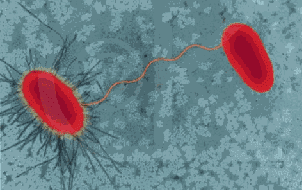 |
| What is the scientific name of the bacteria that reside in the intestines of mammals, including humans? | E. coli (Escherichia coli) p572 |
| What do you call the photosynthetic oxygen producing bacteria? | Cyanobacteria (a.k.a. - Blue-green bacteria) |
| ______ is the movement of an organism toward or away from chemicals, such as oxygen, nutrients, or pheromones). | chemotaxis p558 |
| Prokaryotes reproduce asexually in a process called _____. | binary fission p560,  |
| Under ideal conditions, some prokaryotes (including E. coli) can divide every ______. | 20 minutes (At this rate, 1 bacterium could become a million in less than 7 hours. At this rate, 1 bacterium could give rise to enough bacteria to outweigh the Earth in only two days!) p560 |
| The uptake of foreign DNA by prokaryotes from their surroundings is called ____. | transformation p562 |
| In the process of _____, DNA can be transferred from one prokaryote to another by a virus called a bacteriophage. | transduction p562, 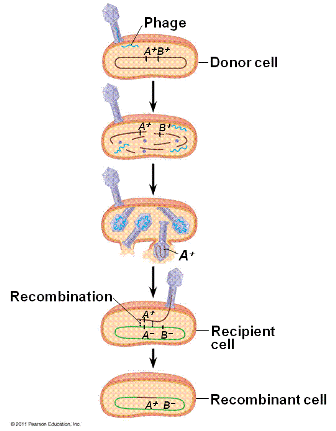 |
| Describe a typical bacterial chromosome. | One double-stranded circular DNA molecule associated with a small amount of protein (below is a diagram of bacterial chromosome replication) p559,  |
| In prokaryotes, the direct transfer of DNA between two cells that are temporarily joined is called _____. | conjugation (can happen in eukaryotic ciliates also in a sexual process in which the two cells exchange haploid micronuclei) p562,  |
| Any organism that needs only carbon dioxide in some form as a carbon source is called a(n) ____. | autotroph (The carbon dioxide can be in the dissolved form of the bicarbonate ion, HCO3-) p564 |
| A catabolic pathway in which inorganic molecules other than oxygen accept electrons at the "downhill" end of the electron transport chain is called ____. | anaerobic respiration (Examples of alternate electron acceptors include the nitrate ion, NO3-, and the sulfate ion, SO4-2) G-2, p564 |
| A catabolic process that makes a limited amount of ATP from glucose, or other organic molecules, without an electron transport chain and that produces a characteristic end product, such as ethyl alcohol or lactic acid, is called ____. | fermentation (Anaerobic respiration is different from fermentation because it has an electron transport chain with something other than oxygen accepting the electrons. Since it has an electron transport chain, anaerobic respiration produces many more ATP than fermentation) G-14, p564 |
| Any organism that causes disease, including quite a few prokaryotic species, is called a(n) ____. | pathogen (Although pathogenic prokaryotes are the best known of the prokaryotes, they represent only a small fraction of prokaryotic species. There are no known pathogenic Archaeans. Bacteria cause about half of all known human diseases.) p570 |
| Where are two places that you would find bacteria that have symbiotic relationships with humans? | Skin and intestines (There may be up to 150 bacterial species with a density of 10 million cells per square centimeter. Our intestines are home to 500 - 1000 species of bacteria, most of them mutualistic that help us process our food. Because bacterial cells are so small, there are actually more bacterial cells in and on a human body than there are human cells) p571 |
| The disease caused by a bacterium that uses Deer Ticks as vectors for transmission to humans is called _____. | Lyme disease (If you see one of these ticks or the bull's-eye rash in the photo below, see your doctor right away. Try to save the tick and bring it to the doctor also.) p571, 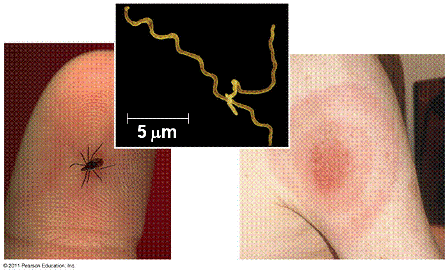 |
What is "E" in the picture below?,  | flagella p573,  |
| What type of organism is required to change milk into cheese or yogurt? | Bacteria p572 |